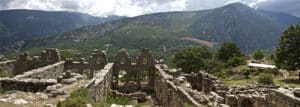Chosen by The Sunday Times as one of the top 10 hiking trails in the world, Turkey’s Lycian Way offers an unforgettable journey through time, nature, and Mediterranean beauty. This 540 km long-distance trail weaves through ancient ruins, pine forests, seaside cliffs, and traditional Turkish villages, making it one of the most rewarding hikes on the planet.
Whether you’re tackling the full route or walking just a scenic section, the Lycian Way offers an extraordinary blend of history, culture, and nature.
What and Who Was Lycia?
The Lycians were an indigenous people of Asia Minor living in what is now part of Turkey’s Mediterranean Riviera running from Fethiye to Antalya. This rugged and mountainous region rises up sharply from the brilliant turquoise sea with peaks reaching over 3000 meters.
Founded in 167/168 BC, the Lycian Federation was not a kingdom, dynasty, or empire of any sort. Its leaders – the Lyciarch or Lyciarhissa – were elected annually! All citizens had equal rights under the Federation, and its republican principles influenced the US Constitution.
Lycians had their own language and pantheon, although both of those became Hellenized under Alexander the Great. The Federation alternated between being a free state and having some autonomy under the umbrella of an invading empire. It was successively absorbed by the Greeks, Romans, Byzantine, and Ottoman Empires until it was inherited by the Turkish Republic by which time all that was left of the Lycians and their society were the ruins we see today.
Lycian Way Hiking Guide
To hike the entirety of the Lycian Way’s 540 km, one would need roughly 29 days! However, if you don’t have 29 days, you can still experience the route’s best sections in smaller, shorter chunks.
Kate Clow, a British-Turkish woman, first conceived the Lycian Way, which opened in 1999, as a way to use sustainable tourism to protect some of these ancient roads. Cloud’s The Lycian Way hiking guide is still the definitive guidebook for the hike. It suggests six main options:
- Coastal and inland options between Kabak and Yediburunlar
- A direct route from Sidyma to Xanthos
- The St Nicholas Way – through the Alacadağ foothills, linking Byzantine churches to the Lycian Way
- Coastal route – Tekirova, Phaselis, Asagikuzdere, Goynuk Yaylasi, Hısarçandır, Çitdibi, Geyikbayırı
- Inland route – Ulupınar, Beycik, Yukari Beycik, pass over Tahtalı Dağı, Çukuryayla, Yayla Kuzdere, Gedelme, Goynuk Yaylasi, where it joins the coastal trail.
- The Lyra Way – a more difficult variation on the inland route – which leaves the route above at Beycik, circles Tahtalı on the north side, and rejoins the route at Çukuryayla.
More than just hiking, this trek offers multiple places of interest along the way.
- The principal cities of ancient Lycia were Xanthos, Patara, Myra, Pinara, Tlos, and Olympos, which have a variety of ruins including fortresses, acropolises, and the distinctive Lycian rock-cut tombs
- Letoon – the sacred center of Lycia with temples to Leto, Artemis, and Apollo
- Kekova-Simena – underwater ruins that can be visited (from above) on boat tours
- Lesser-known but no less beautiful ancient cities of Arycanda, Sidyma, and Cyaneae, the latter having more than 300 of Lycia’s distinct pillar tombs!
The nature along the trek is as stunning as the ancient cities and ruins. Turkey’s famous Butterfly Valley is here, as well as Saklikent (Hidden City) Gorge and many beaches and bays which offer opportunities for kayaking, scuba diving, and paragliding.
How to Hike the Lycian Way
You can reach the starting points via bus from either the Dalaman or Antalya airports.
Waymarking signs are placed at regular intervals to guide you along the way. These are mostly painted on stones or trees as opposed to being actual signs though, so you do need to keep your eye out for them! Never fear, as there are also official signposts dotted along the route.
Despite the signposting, safe trekking means that you have with you something with GPS, a map or hiking guide like Clow’s or Trekopedia, and that you have pre-planned your route! No matter how well you plan, the likelihood of getting lost at least once is high!
Where do you stay when hiking the Lycian Way? No, it’s not all camping. Although there are many options available for that, if you want to camp! Hotels, motels, and B&Bs, including some converted traditional village homes, can be found in most locations and villages along the way and are tailored to all budgets.
Lycian Way Turkey Trekking Tips
Hiking season is long, and the Lycian Way doesn’t technically close. However, extreme summer heat and harsh winter snows do mean there are more advantageous times to make the trip. The best time to go is in the spring or late autumn months.
Make sure you have a sturdy backpack in which you can pack essentials like: a water bottle, guide/maps, pocket knife, flashlight or headlamp, lighter, basic first-aid kit, sunscreen, rain gear, swimsuit, towel, and a change of clothes. We recommend quick-drying materials, especially for pants and socks, and moisture-wicking fabrics. You’ll definitely want sunglasses and a hat as well. We also recommend investing in proper hiking boots. Many paths along the route are steep and rocky. This is not a sandals or trainers kind of hike.
One of the most important Lycian Way trekking tips concerns water. While bottled water can be purchased in most shops, there are long stretches between villages. Make sure that you not only carry sufficient water with you, but that you’ve also mapped out where natural spring water might be available.
With these Lycian Way Turkey trekking tips in mind, you can absolutely hike the Lycian Way on your own. Or! You can leave the planning and logistics to us. Get in touch with us to plan your bespoke Lycian Way trek and let us take care of route mapping, accommodation reservations, and more.
Plan your self-guided adventure with us and experience it on your own terms.





